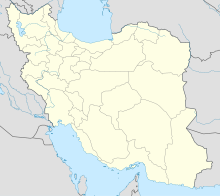Tacht-e Suleiman
Coordinates: 36 ° 36 ′ 14 ″ N , 47 ° 14 ′ 6 ″ E
The Tacht-e Suleiman ( Persian تخت سلیمان, 'Throne of Solomon') is a building complex consisting of the palace, the fire temple with peribolos and fortifications from the late Sassanid period (around 420–640 AD), which was built over in the 13th century for a palace complex. It is located on a travertine hill at an altitude of 2200 m, 250 km in the eastern Shahrestan (district) Takab of the province of West Azerbaijan . The Tacht-e Suleiman has been a UNESCO World Heritage Site since 2003 . 3 km away are the sintered limestone cone Zendan-i Suleiman (Solomon's prison) with a settlement and a sanctuary, as well as the Tepe Madjid tumulus. The facility is surrounded by a wall about 1100 m long.
location
The Tacht-e Suleiman is located in a valley area where two different folding zones of the Iranian highlands meet. To this day, a series of warm springs of calcareous water represents a remnant of the earlier volcanism. Where these springs are enriched with gases, the spring pots form limestone deposits on their edges.
The temple complex was built around a 100 m diameter spring lake in which calcium bicarbonate water rises at a constant temperature of around 21 degrees. At the edge of the lake , the lime contained in the water sintered and created a hill that rises about 50 m above the surroundings. Several drainage channels created over the centuries have prevented the lake edge from rising higher, but have widened the travertine hill.
history
The oldest documented traces of settlement date from the Achaemenid period. There is evidence of a larger development since the Sassanids.
In the 5th century, a large temple complex made of unfired bricks with a surrounding wall was built here. In the 6th century, the plant was built over in stone and the Zoroastrian fire sanctuary Atur Guschnasp was moved here. With this relocation of the central Reich Fire Temple, the place name Djiz also seems to have been transferred here. The palace served the Sassanid great kings during their stays on site. Since Bahram V at the latest , the Sassanid Persian kings came here after their accession to the throne and before major campaigns to attend religious ceremonies.
The Eastern Roman Emperor Herakleios seems to have destroyed the complex in the 620s.
After the end of the Sassanid Empire , the fire cult could be continued into the 10th century, but parts of the complex were already used by a Muslim settlement.
In the 13th century the Ilkhan Abaqa Chan had all residents resettled and built a hunting palace on the remains of the Sassanid temple complex. Parts of the old system that have been preserved have been included. During this period the place was called Saturiq / Soqurluq.
Since the 14th century, the previous names fell into oblivion and the name "Tacht-e Soleiman" became common; Other places in the area were also named after the Islamic tradition of Solomon: the cone of Zendan-i Soleiman, the neighboring summit in the north-east “Kuh-e Bilqis ”, the massif in the south-west “Tavile-ye Soleiman”.
Research history
A first detailed description of the ruins of the Tacht-e Soleiman and the Zendan-i Soleiman was written in 1838 by Henry Rawlinson .
In 1937 the first aerial photographs of the place were made, which was then followed by an investigation by Arthur U. Pope and his expedition on behalf of the American Institute for Iranian Art and Archeology.
The research of the Eurasia Department of the DAI was carried out by Rudolf Naumann , Hans Henning von der Osten (1899–1960) D. Huff, W. Kleiss and U. Harb in the years 1959–1966 and 1968–1975. The extensive documentation of the excavations is kept in the Eurasia Department in Berlin.
literature
- Dietrich Huff: Takht-I-Suleiman - The throne of Solomon in the Iranian mountains. In: Image of Science . 7/1982.
- Wolfram Kleiss: Zendani-I-Suleiman. The structures. Wiesbaden 1971.
- Rudolf Naumann: The ruins of Tacht-e Suleiman and Zendan-e Suleiman and the surrounding area , Berlin 1977, here as a pdf download
- Josef Wiesehöfer : "King's Fire" and "Solomon's Throne". The Tacht-e Sulaiman in Iranian Azerbaijan. In: AC Messner, K. Hirschler (ed.): Holy places in Asia and Africa. Spaces of divine power and human worship. Schenefeld / Hamburg 2006, ISBN 3-936912-19-X , pp. 59-77.
Web links
- Entry on the UNESCO World Heritage Center website ( English and French ).
- Tacht-e Suleiman . In: Ehsan Yarshater (Ed.): Encyclopædia Iranica (English, including references)
- Pictures from Tacht-e Suleiman ( Memento from March 12, 2007 in the Internet Archive )






